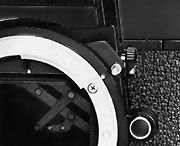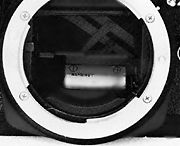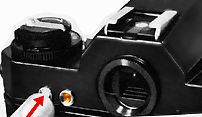Main Features of Nikkormat
ELW
1. When used with the Auto
Winder AW-1,
the Nikkormat ELW will automatically wind the film after releasing the shutter-release
button.
2. It is an automatic exposure control camera with an aperture-priority automatic
electronic shutter speed control system. A manual shutter-speed-priority system can
also be employed.
3. It is equipped with an exposure memory lock, convenient when taking pictures with
severe brightness differences between subject and background.
4. At the automatic setting, the shutter speed can be set from 1/1000 to a full 4
seconds, and all speeds in between, and the shutter speed can be visually confirmed
in the viewfinder.
5. At a manual setting, exposure can be set using the match needle manual system.
The shutter speed can be set from 1/1000 to a full 4 seconds, using pre-calibrated
settings plus B.
6. The Nikkormat ELW has a built-in TTL center-weighted exposure meter. The meter,
coupled with any Nikkor interchangeable lens with the Nikon bayonet mounting system,
can perform not only at full aperture but also stop-down measurement as well, using
the depth-of-field preview button.
7. The reliability of the meter is insured by the adoption of a raw but very reliable
design of monolithic Integrated Circuit and Functional Resistance Element (FRE) in
its electronic circuitry.
8. Even if the exposure meter battery is depleted, the shutter will operate at 1/90
sec. mechanically.
9. The shutter can be synchronized with an electronic flash up to the high speed
of 1/125 sec.
10. To avoid accidental or improper operation, the following safety locks have been
provided. Some of these are popular features which can be found on most modern manual
focus SLRs, but sinc the ELW was essentially a 1976 imaging tool, these are considered
innovative features that were designed to help one to make less mistakes on a photo
session:
- (i) To lock the shutter-release button and the exposure meter power source, set the shutter-release button lock and the film-advance lever at their locked position (flush against the camera).
- (ii) The shutter speed dial locks when it has been set on automatic (A). For manual exposure control, release the lock by pressing the silver button at the center of the shutter speed dial, and set the dial to the desired speed.
- (iii) The rewind crank cannot be raised unless you slide back the back cover lock. This prevents accidental opening of the back cover.
- (iv) The ASA setting ring cannot be turned without pressing the ASA dial release lock.
Refer to the main
reference map section
for the location of each of these items.
The Nikkormat ELW is an aperture-priority (You select the aperture for depth of field
control while the camera's electronic circuit will provide a matching shutter speed)
electronic automatic exposure camera. It requires battery to power most of its functions.
However, just like any of the cameras designed during the late seventies and early
eighties, even if the ELW without any battery installed inside or depleted, the camera
still have an emergency back up speed of 1/90 sec to operate the camera (Very close
to the conventional hand holdable speed of 1/125 sec if you are using
an ASA 100 film - perhaps you can treat it as 1/3 stop exposure compensation). But
first, you have to locate the whereabout is the battery compartment to store
the 6V silver oxide/alkaline-manganese battery.
Battery Issues
Installing the battery
Either a 6-volt silver-oxide or alkaline-manganese battery is used to power both
the exposure meter and the electromagnetic shutter-speed controlling circuits. The battery chamber is
inside the mirror box which
you have to unmount the lens before you can install or remove the battery.
1. To install the battery, first remove the lens from the camera and lock the mirror
in the up position by turning the milled mirror-lock lever upward to gain access
to the battery chamber in the mirror box.


2. Then with a finger, press the battery chamber lid to the left at the indent and
lift it up.
3. When inserting the battery, be sure to align the positive and negative (+ and
-) terminals correctly as shown underneath the battery chamber lid.
 |
To close the lid, press down. Remember to return the mirror to its original focusing and viewing position (Anyway, you won't be able to view anything through the viewfinder if you have forgotten to lower down the mirror). |
Caution: If the battery is installed in the opposite alignment, its energy will be depleted within a matter of minutes. Also be careful NOT to touch the shutter curtain and the mirror surface.
Battery test
The battery should be checked when:
* A new battery is installed.
* A camera is about to be used after a long period of storage.
* It is suspected that the battery has been depleted after a long period of use.
Behind the camera, just below the film rewind crank, there is a button to test the battery, just next to it is a pilot lamp to show the strength of the battery level. Press the battery check button on the back of the camera. A built-in battery checker lets you check the condition of the battery.
 |
Depress the white button and the signal lamp will glow with a bright orange light, indicating that the battery has been properly inserted and its power is adequate. This button has changed to a lever type in the Nikon FE later in 1978. |
Well, this is not hard to understand, since the mid seventies are still essentially very conservative and users were still very defensive towards automation in SLR design, most electronic models marketed those days were either provide a mechanical backup speed or provide sufficient battery checker features in a camera. You can say these are marketing features.
Note: The battery can be tested regardless of the position of film-advance lever and shutter button lock .
Replacing the battery
 |
When the battery check lamp does not glow when pressing the battery check button, replace the battery with a new one. |
(2) Open the battery chamber lid.
(3) Hold the camera upside down, and push the battery chamber lid. The battery will roll out of the chamber.
Well, I know it may sound ridiculous
to place the battery chamber under the mirror box and making changing power cell
so inconvenient (You have to remove the lens first and careful not to spoilt the
mirror or worst still, the metal blades of the shutter curtain). Anyway, this was
halved in power supply (From 6V to a pair of 1.5V or a 3V) when the compact electronic
Nikon FE and even the equally compact sized mechanical Nikon FM
(Power is merely used for metering for that model) was introduced a year later in
1977.
Preventing unnecessary discharge
To prevent unnecessary discharge or drainage of the power cell, alway remember to
set the film advance lever and the shutter button lock in the off position, except
when taking pictures. Auto power off feature was not available during that time,
until the super compact Nikon EM
in 1979.
Cold resistability of battery
Although both the silver-oxide battery and alkaline-manganese battery performs well
in low temperature performance, there should be a marked tendency for battery performance
to deteriorate below 0°C (32°F). Therefore, it is recommended that a new
battery be used and the camera itself be protected from low temperatures when taking
pictures below 0°C (32°F). Nikon has designed a anti-cold battery holder,
but that was designed with the battery chamber locates outside at the base of the
camera body and thus it cannot be used on the EL nor the FT bodies.
A battery which temporarily deteriorates due to low temperature can continue to be
used, as its capacity recovers when the temperature rises back to normal.
* Wipe both battery terminals with a soft
and dry cloth or paper before inserting it into the camera.
* The battery may conduct poorly due to the
leakage of battery fluid, etc. when it is kept inside the battery chamber for a long
time. When such leakage occurs, clean the battery chamber and replace the poor battery
with a new one.
* When the camera is not in use for a long
time, remove the battery and store it separately.
* Do not disassemble, short-circuit, or burn
batteries.
|
Previous | Introduction
| Next | Mount and remove a lens,
Maximum Aperture Indicator, when use it with AW-1 Winder (2/8)
Back to Main
Index Page of Nikkormat EL-W
| Back | to
Main Index Page of Nikkormats EL Series
| Back | to
Main Index Page of Nikkormats
History
& Background
of Nikkormat Cameras
"Nikomat" Picture Library of Japanese
local version
Outline the major key features and differences of various models
The
Camera Bodies
| FT | FS | FTn | EL | FT2 | ELW | FT3 | EL2
| Main Reference
Map
|
HTML Format: FT | FS | FTn | EL | FT2 | ELW | FT3 | EL2 | AW-1 Motor Winder
PDF Format: FT
| FS | FTn | EL | FT2 | ELW | FT3 | EL2 | AW-1 Motor Winder
| Specifications |
FT
| FS | FTn | EL | FT2 | ELW | FT3 | EL2
| Message Board | for
your favourite Nikkormats
| Message Board | for your Nikon Optics
in a shared environment
| Message Board | Specifically for Dispose or Looking for Nikon/Nikkor Photographic
Equipment
 |
The Eyes of Nikon:- |
Fisheye-Nikkor Lenses - Circular | Full Frame | Ultrawides Lenses - 13mm15mm18mm20mm | Wideangle Lenses - 24mm28mm35mm |
Standard Lenses - 45mm 50mm 58mm | Telephoto Lenses - 85mm105mm135mm180mm & 200mm |
Super-Telephoto Lenses - 300mm 400mm 500mm 600mm 800mm 1200mm |
Special Application lenses:
Micro-Nikkor Lenses - 50mm~55mm -60mm 85mm -105mm 200mm Micro-Zoom 70-180mm
Perspective Control (PC) - 28mm 35mm PC-Micro 85mm
Dedicated Lenses for Nikon F3AF: AF 80mm f/2.8 | AF 200mm f/3.5 EDIF
Depth of Field Control (DC): 105mm 135mm
Medical Nikkor: 120mm 200mm
Reflex-Nikkor Lenses - 500mm 1000mm 2000mm
Others: Noct Nikkor | OP-Nikkor | UV Nikkor 55mm 105mm | Focusing Units | Bellows-Nikkor 105mm 135mm
Nikon Series E Lenses: 28mm35mm50mm100mm135mm | E-Series Zoom lenses: 36~72mm75~150mm70~210mm
MF Zoom-Nikkor Lenses: 25~50mm | 28~45mm | 28~50mm | 28~85mm | 35~70mm | 36~72mm E | 35~85mm | 35~105mm | 35~135mm |
35~200mm | 43~86mm | 50~135mm | 50~300mm | 70~210mm E | 75~150mm E | 80~200mm | 85~250mm |
100~300mm | 180~600mm | 200~400mm | 200~600mm | 360~1200mm | 1200~1700mm
Tele-Converters: TC-1 | TC-2 | TC-200 | TC-201 | TC-300 | TC-301 | TC-14 | TC-14A | TC-14B | TC-14C | TC-14E | TC-16 | TC-16A | TC-20E
![]()
Nikon F
| Nikon F2 |
Nikon
F3
| Nikon F4 |
Nikon
F5
| Nikon F6 |
Nikkormat / Nikomat |
Nikon FM
| Nikon FE/ FA | Nikon EM/FG/FG20 | Nikon Digital SLRs | Nikon - Other models
MIR Supports for Photographic Community: Various Message Boards/Community
Forums
Nikon
F-series|
Nikon
F2-series|
Nikon
F3-series|
Nikon F4-series| Nikon
F5-series|Nikkormat/Nikomat-series
Nikon FM-series|Nikon
FE-series|Nikon
FA|Nikon
Digital
SLR
series|Various
Nikon
Models|Nikkor
Optic
-shared
Others:- Free Trade Zone - Photography| Free Trade Zone - Business Community |Free To Zouk - Photographic Community
Apple's Mac Public Community Message Board | Windows based PC &
Apple/Mac
Public Community Trade Exchange Centre
Recommended links to understand
more technical details related to the Nikkor F-mount and production Serial Number:
http://rick_oleson.tripod.com/index-153.html by: my friend, Rick Oleson
http://www.zi.ku.dk/personal/lhhansen/photo/fmount.htm by: Hansen, Lars Holst
http://www.mir.com.my/rb/photography/hardwares/nikonfmount/lens2.htm
http://www.photosynthesis.co.nz/nikon/serialno.html
About
this photographic
site.
Home - Photography
In Malaysia
![]()
Copyright
© 1998.
HIURA Shinsaku ® ; Nikomat ML, Japan,
in collaboration with leofoo ®. MIR Web Development Team.
* Credit: A
Great thanks to Mr Denis Pleic for his volunteering
effort to reedit content and and patching some grammatical mistakes found in this
section of the PIM site. Miss
Rissa (Marketing) & Edward
(Techical) of Shriro Malaysia, distributor of Nikon cameras in Malaysia, in providing
so many useful inputs to make this site possible. Mr Hong,
Ipoh for lending me his FT2 to take some of the images used in this site. This site
is created for his eldest son, Yuen who has picked up his father's hobby and
the FT-2. My friend, John Walls from Florida, US for his images of the FTn
body and the Zoom Nikkor
43-86mm.
[Left Brain][Right brain][Home-MIR] [Invention][Art & Design][Clubs]
[Portfolios][On assignments] [Trading room][Knowledge & Resources] [Free-trade-zone][Thoughts & opinions][Links]